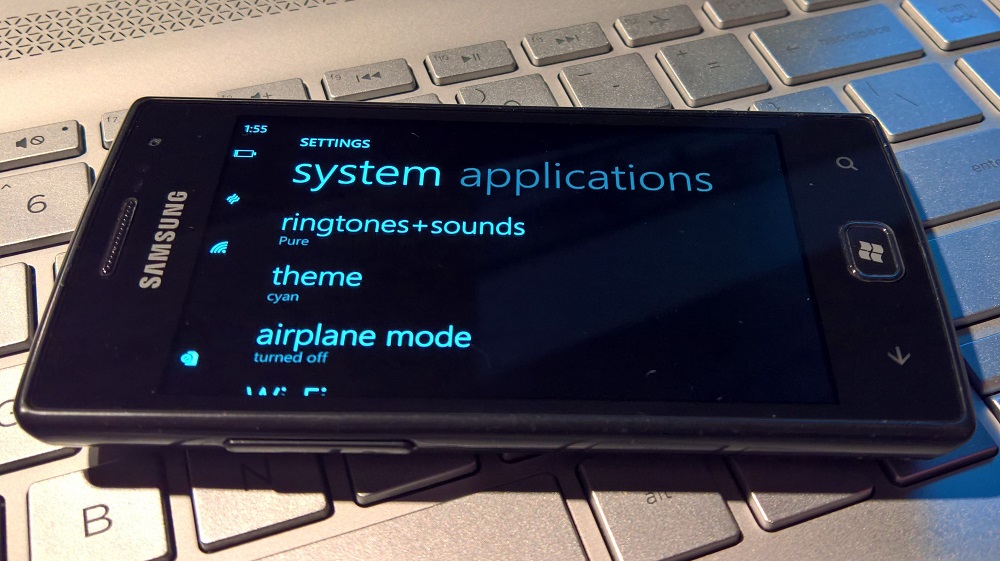How to hide the StatusBar in Landscape on UWP
Windows 10 Mobile has lost a lot of the awesome UI/UX from the good ol’ Windows Phone 7 era, but there’s one thing that they kept around: the enormous amount of space the statusbar takes up in landscape view. I still love the look and feel of the old Windows Phone, but this thing has been bugging me since, well, my first smartphone.

In my apps, I prefer to hide the statusbar when the user goes into landscape mode, but just let it stay where it is when in portrait mode. It includes some useful information, after all, and in portrait the amount of used space is acceptable. Here’s my solution:
tl;dr:
if (ApiInformation.IsTypePresent("Windows.UI.ViewManagement.StatusBar"))
{
Window.Current.SizeChanged += async (sender, e) =>
{
var statusBar = StatusBar.GetForCurrentView();
if (ApplicationView.GetForCurrentView().Orientation == ApplicationViewOrientation.Landscape)
await statusBar.HideAsync();
else
await statusBar.ShowAsync();
};
}To get access to the statusbar, we first need to reference the Mobile Extensions, as Mobile’s the only SKU of Windows 10 where the statusbar is available. This can be done using the ‘Add reference’ dialog, which can be found by right-clicking ‘References’ in the Solution Explorer in Visual Studio. After navigating to Universal Windows - Extensions in the left menu, make sure you check the checkbox before the version of the Mobile Extensions you’re targeting:

Now we can get access to the statusbar, how do we do that? The
StatusBar class has a static method called
GetForCurrentView() to get access to the statusbar, so this
is easy:
using Windows.UI.ViewManagement;
var statusBar = StatusBar.GetForCurrentView();Now we want to hide the statusbar if we’re in landscape orientation,
else we want to show the statusbar. To find out the orientation we can
use the ApplicationView class, which is also in the
Windows.UI.ViewManagement namespace:
if (ApplicationView.GetForCurrentView().Orientation == ApplicationViewOrientation.Landscape)
await statusBar.HideAsync();
else
await statusBar.ShowAsync();We want to execute this every time the orientation of the device
changes, but unfortunately, there is no OrientationChanged
event. What we want to use is the
Window.Current.SizeChanged event in the
Windows.UI.Xaml namespace. We can hook this all up this way:
Window.Current.SizeChanged += async (sender, e) =>
{
var statusBar = StatusBar.GetForCurrentView();
if (ApplicationView.GetForCurrentView().Orientation == ApplicationViewOrientation.Landscape)
await statusBar.HideAsync();
else
await statusBar.ShowAsync();
};However, when this code is executed on a non-Mobile Windows 10
device, it will generate a runtime exception. Of course, that’s not what
we want; this code should just be ignored if it doesn’t apply. To
accomplish this we can check if the StatusBar type is
available, before executing the code:
if (ApiInformation.IsTypePresent("Windows.UI.ViewManagement.StatusBar"))
{
Window.Current.SizeChanged += async (sender, e) =>
{
var statusBar = StatusBar.GetForCurrentView();
if (ApplicationView.GetForCurrentView().Orientation == ApplicationViewOrientation.Landscape)
await statusBar.HideAsync();
else
await statusBar.ShowAsync();
};
}Finally, where should we place this snippet? I want my entire
application to behave this way, so I put the code to set this up in the
OnInitializeAsync() method of the Template 10 BootStrapper. You can
also choose to enable this functionality later in the runtime of your
app. I’d recommend moving the event handler into its own method, so the
functionality can easily be disabled by unsubscribing the event:
Window.Current.SizeChanged += HideStatusBarIfLandscape;
Window.Current.SizeChanged -= HideStatusBarIfLandscape; // Disabling by unsubscribingIn this case, you should also check for availability of the statusbar, before subscribing to the event. If the code inside the handler won’t run anyway, subscribing is just unnecessary overhead.
I think this little snippet of code belongs in almost every app, and I’ll definitely use it in most of mine.